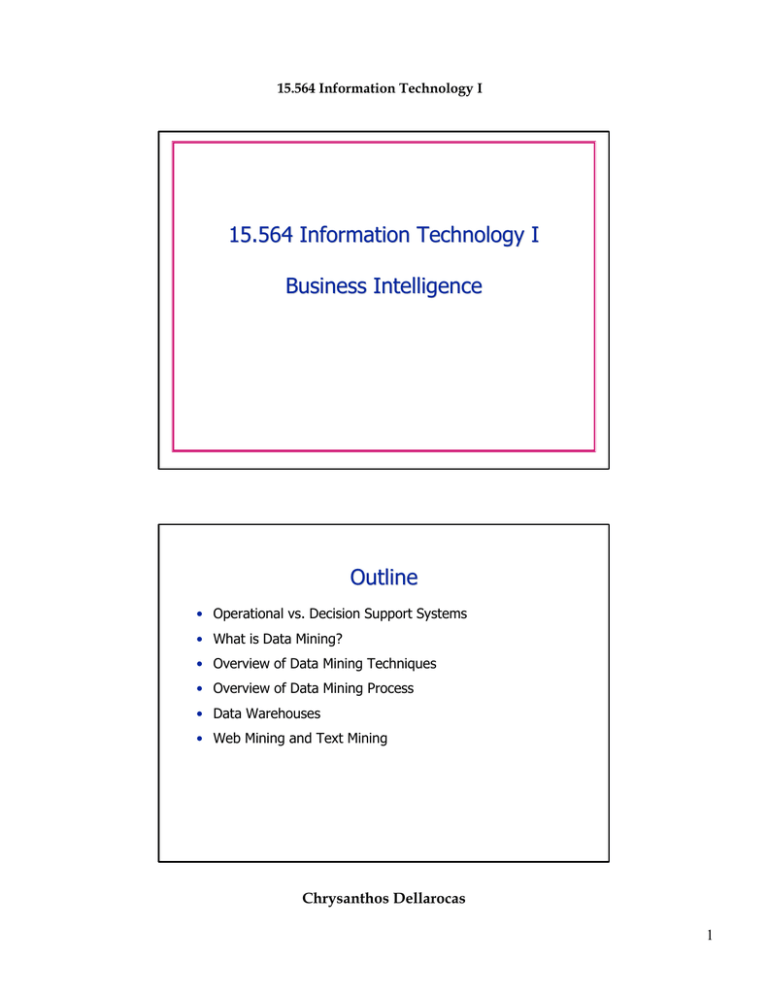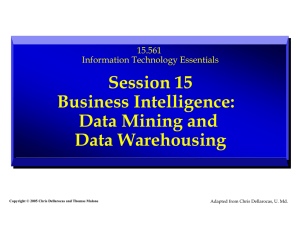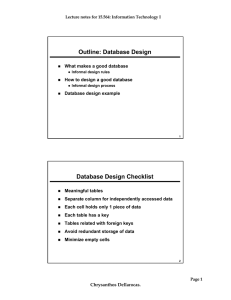15.564 Information Technology I Business Intelligence Outline
advertisement

15.564 Information Technology I 15.564 Information Technology I Business Intelligence Outline • Operational vs. Decision Support Systems • What is Data Mining? • Overview of Data Mining Techniques • Overview of Data Mining Process • Data Warehouses • Web Mining and Text Mining Chrysanthos Dellarocas 1 15.564 Information Technology I Operational vs. Decision Support Systems Decision support processes Transactional processes Linkages with Suppliers, customers, partners Operational vs. Decision Support Systems • Operational Systems – Support day to day transactions – Contain current, “up to date” data – Examples: customer orders, inventory levels, bank account balances • Decision Support Systems – Support strategic decision making – Contain historical, “summarized” data – Examples: performance summary, customer profitability, market segmentation Chrysanthos Dellarocas 2 15.564 Information Technology I Example of an Op. Ap.: Ap.: Order Entry This screenshot is from the Microsoft® Access® software program. Example of a DSS ap: ap: Annual performance summary This screenshot is from the Microsoft® Access® software program. Chrysanthos Dellarocas 3 15.564 Information Technology I What is Data Mining? • Combination of AI and statistical analysis to discover information that is “hidden” in the data – associations (e.g. linking purchase of pizza with beer) – sequences (e.g. tying events together: marriage and purchase of furniture) – classifications (e.g. recognizing patterns such as the attributes of customers that are most likely to quit) – forecasting (e.g. predicting buying habits of customers based on past patterns) Sample Data Mining Applications • Direct Marketing – identify which prospects should be included in a mailing list • Market segmentation – identify common characteristics of customers who buy same products • Customer churn – Predict which customers are likely to leave your company for a competitor • Market Basket Analysis – Identify what products are likely to be bought together • Insurance Claims Analysis – discover patterns of fraudulent transactions – compare current transactions against those patterns Chrysanthos Dellarocas 4 15.564 Information Technology I Case study: Bank is losing customers… • Attrition rate greater than acquisition rate • More profitable customers seem to be the ones to go Case study: Bank of America • Bank wants to expand its portfolio of home equity loans • Direct mail campaigns have been disappointing Chrysanthos Dellarocas 5 15.564 Information Technology I The “Virtuous Circle” of Data Mining • Identify the business problem • Use data mining to transform “the data” into actionable information – What is the “right” data and where do we get it from? – What are the “right” techniques? • Act on the information • Measure the results Business uses of data mining Essentially six tasks… • Classification – Classify credit applicants as low, medium, high risk – Classify insurance claims as normal, suspicious • Estimation – Estimate the probability of a direct mailing response – Estimate the lifetime value of a customer • Prediction – Predict which customers will leave within six months – Predict the size of the balance that will be transferred by a credit card prospect Chrysanthos Dellarocas 6 15.564 Information Technology I Business uses of data mining • Affinity Grouping – Find out items customers are likely to buy together – Find out what books to recommend to Amazon.com users • Clustering – Difference from classification: classes are unknown! • Description – Help understand large volumes of data by uncovering interesting patterns Overview of Data Mining Techniques • Market Basket Analysis • Memory-Based Processing (Collaborative Filtering) • Automatic Clustering • Decision Trees and Rule Induction • Neural Networks Chrysanthos Dellarocas 7 15.564 Information Technology I Market Basket Analysis • Association and sequence discovery • Principal concepts – Support or Prevalence: frequency that a particular association appears in the database – Confidence: conditional predictability of B, given A • Example: – – – – – – – Total daily transactions: 1,000 Number which include “soda”: 500 Number which include “orange juice”: 800 Number which include “soda” and “orange juice”: 450 SUPPORT for “soda and orange juice” = 45% (450/1,000) CONFIDENCE of “soda à orange juice” = 90% (450/500) CONFIDENCE of “orange juice à soda” = 56% (450/800) Applying Market Basket Analysis • Create co-occurrence matrix – What is the right set of items??? • Generate useful rules – Weed out the trivial and the inexplicable from the useful • Figure out how to act on them • Similar techniques can be applied to time series for mining useful sequences of actions Chrysanthos Dellarocas 8 15.564 Information Technology I MemoryMemory-based reasoning • Helps predict unknown attributes of customers/situations, based on attributes on their nearest neighbors • Principal set of techniques behind Web recommendation engines • Otherwise known as collaborative filtering Chrysanthos Dellarocas 9 15.564 Information Technology I Example: Amazon.com book recommendations • Example: Identify books to recommend to customers • Company keeps log of past customer purchases • Represent each customer as a vector whose components are the past purchases • Define a “distance” function for comparing customers • Based on this distance function, identify the customer’s nearest neighbor set (NNS) • Identify books that have been purchased by a large percentage of the nearest neighbor set but not by the customer • Recommend these books to the customer as possible next purchases (Screenshot from Amazon.com showing book recommendations.) Chrysanthos Dellarocas 10 15.564 Information Technology I Another example: Personalized restaurant recommendations • Alice is asking Zagat.com for a personalized rating of “Border Cafe” • Alice has already submitted ratings for 20 other restaurants in the past 12 months • Zagat.com finds other members whose ratings for those 20 restaurants are similar to Alice’s • Zagat.com calculates the average (or weighted average) rating that these nearest neighbors have given to Border Cafe • This is Alice’s personalized rating of Border Cafe • Note that this may be quite different from the average rating of Border Cafe based on the entire population of raters! Clustering • Divide (segment) a database into groups • Goal: Find groups that are very different from each other, and whose members are similar to each other • Number and attributes of these groups are not known in advance Chrysanthos Dellarocas 11 15.564 Information Technology I Clustering (example) Buys groceries online X X X X X X X X Income Decision Trees Income > $40,000 Job > 5 Years Low Risk High Risk High Debt High Risk Low Risk • Data mining is used to construct the tree • Example algorithm: CART (Classification and Regression Trees) Chrysanthos Dellarocas 12 15.564 Information Technology I Decision tree construction algorithms • Start with a training set (i.e. preclassified records of loan customers) – Each customer record contains • Independent variables: income, time with employer, debt • Dependent variable: outcome of past loan • Find the independent variable that best splits the records into groups where one single class (low risk, high risk) predominates – Measure used: entropy of information (diversity) – Objective: • max[ diversity before – (diversity left + diversity right) ] • Repeat recursively to generate lower levels of tree Decision Tree pros and cons • Pros – One of the most intuitive techniques, people really like decision trees – Really helps get some intuition as to what is going on – Can lead to direct actions/decision procedures • Cons – Independent variables are not always the best separators – Maybe some of them are correlated/redundant – Maybe the best splitter is a linear combination of those variables (remember factor analysis) Chrysanthos Dellarocas 13 15.564 Information Technology I Neural Networks • • • Powerful method for constructing predictive models w13 Each node applies an activation function to its input 1 Activation function results are multiplied by wij and passed on to output 2 w14 3 w36 w23 w15 4 w46 6 w24 w56 w25 5 Inputs Output Hidden Layer Neural Networks • Weights are determined using a “training set”, I.e. a number of test cases where both the inputs and the outputs are known w13 w14 1 3 w36 w23 w15 4 w46 6 w24 2 w56 w25 5 Inputs Output Hidden Layer Chrysanthos Dellarocas 14 15.564 Information Technology I Neural Networks • • Example: Build a neural net to calculate credit risk for loan applicants Inputs: annual income, loan amount, loan duration w13 w14 1 3 w23 w15 4 Outputs: probability of default [0,1] • Training set: data from past customers with known outcomes w46 6 w24 2 • w36 w56 w25 5 Inputs Output Hidden Layer Neural Networks • • Start from an initial estimate for the weights Feed the independent variables for the first record into inputs 1 and 2 • Compare with output and calculate error • Update estimates of weights by backpropagating error w13 w14 1 3 w36 w23 w15 4 w46 6 w24 2 w56 w25 5 Inputs Output Hidden Layer Chrysanthos Dellarocas 15 15.564 Information Technology I Neural Networks • Repeat with next training set record until model converges w13 w14 1 3 w36 w23 w15 4 w46 6 w24 2 w56 w25 5 Inputs Output Hidden Layer Neural networks pros and cons • Pros – Versatile, give good results in complicated domains • Cons – NN cannot explain the data – All inputs and outputs must be massaged to [0,1] Chrysanthos Dellarocas 16 15.564 Information Technology I Data Mining Process • Define business problem • Build data mining database • Explore data • Prepare data for modeling • Build model • Evaluate model • Deploy model and results Selecting the right data mining technique Chrysanthos Dellarocas 17 15.564 Information Technology I Evaluating the various techniques What is a data warehouse? • Data Mining has a hard requirement for clean and consistent data • Decision Support Data – Are found in many different databases • within the company • outside the company – Are often inconsistent and “unclean” – In practical terms, locating and integrating all this information in real time is very difficult • Solution: – Create separate repositories of data for decision support ⇒ data warehouses Chrysanthos Dellarocas 18 15.564 Information Technology I Data Warehousing architecture Data Warehousing considerations • What data to include? • How to reconcile inconsistencies? • How often to update? Chrysanthos Dellarocas 19 15.564 Information Technology I Trends in Business Intelligence • Text Mining – Mining patterns from unstructured text data, e.g. from the Web • Software Agent Technologies – Business intelligence on behalf of the consumer – Agents “learn” the preferences and behavior of their human “master” in order to • Search the Web and recommend products • Compare prices and other attributes and select providers • Automatically negotiate – What does this mean for vendors??? To delve deeper • Recommended books Data Mining Techniques: Michael J. A. Berry and Gordon Linoff • Useful collections of links – http://databases.about.com/cs/datamining/ • Case studies and industry – Datamation magazine website http://www.datamation.com Chrysanthos Dellarocas 20






